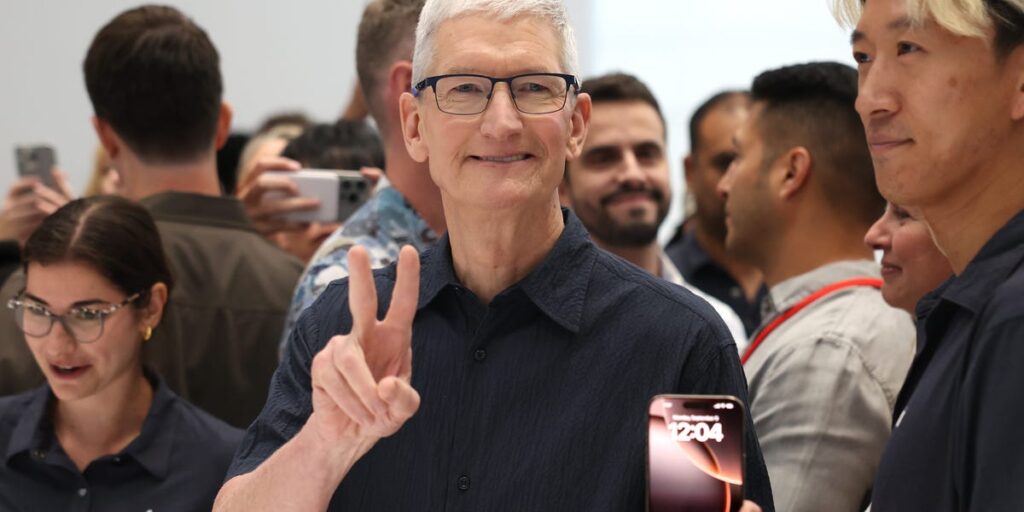Updated
X
Bluesky
Copy link
Impact Link
Save
Saved
Read in app
subscribers. Become an Insider
and start reading now.
Have an account? .
- The original iPhone, which debuted 17 years ago, set the stage for the modern smartphone.
- Apple’s iPhone has since evolved into a powerful computer with professional-grade cameras and AI-focused chips.
- Here’s a look at how the iPhone has changed since its launch in 2007.
About 18 years ago, the technology world changed forever.
When Apple’s cofounder and then-CEO Steve Jobs unveiled the original iPhone on June 29, 2007, he called it “an iPod, a phone, and an internet communicator,” all in one. Although Jobs knew that the iPhone would change the way we communicate and access the internet, perhaps he couldn’t have predicted exactly how impactful it would be.
The first iPhone laid the foundation for the modern smartphone, ushering in the era in which pocket-sized computers that can answer any question with the push of a button became the norm.
Everything from the way we work, communicate, shop, travel, manage our finances, and experience entertainment can be done through a smartphone — and for tens of millions of people worldwide, that’s the iPhone.
The device has become Apple’s cash cow, with the tech giant bringing in $45 billion in revenue from iPhone sales last quarter.
Apple is expected to soon unveil the iPhone 17, a device that has been the subject of rumors and theories from tech enthusiasts and industry insiders. The company has become known for unveiling a new iPhone in September, and CEO Tim Cook has teased this year’s event.
Here’s a look at how the iPhone has evolved from 2007 to now.
The original iPhone (2007)
Apple’s first iPhone from 2007 was the one that started it all. It had a 3.5-inch screen, a 2-megapixel camera, and topped out at just 16GB of storage. It didn’t even support third-party apps yet.
While those specifications seem primitive compared to today’s super-powerful smartphones, the original iPhone was critical in setting the standard for mobile devices for generations to come. Its multi-touch display, for example, was crucial in paving the way for the touch-based operating systems found on smartphones, tablets, and computers around the world.
iPhone 3G (2008)
With the iPhone 3G, Apple added critical new capabilities such as a GPS sensor for location-monitoring, support for 3G networks, and faster performance.
But perhaps most importantly, it introduced the App Store, transforming the iPhone from just a mobile device capable of accessing the internet to a full-blown computing platform.
Today, the App Store hosts nearly 2 million apps, ushering in the booming app economy that made it possible for the Ubers and Snapchats of the world to flourish.
iPhone 3GS (2009)
The iPhone 3GS introduced further refinements to Apple’s smartphone, offering improvements like a better 3-megapixel camera, voice control, and longer battery life.
The new software that launched on the iPhone 3GS was also just as important — it introduced features that have long been the standard, such as cut, copy, and paste actions, as well as support for multimedia messaging.
iPhone 4 (2010)
The iPhone 4 was the first major redesign of the iPhone since its launch in 2007. It had a thinner profile and a sharper shape than its predecessors. It featured a glass body with stainless steel trim around its edges.
The iPhone 4 also introduced the Retina display, which has become a hallmark of Apple’s products ever since. It was the first iPhone to offer FaceTime video-calling.
While the iPhone 4 was generally well-received, it wasn’t immune to criticism, most notably because of a call reception issue that became known as “Antennagate.” Some iPhone 4 owners experienced frequent dropped calls due to an issue with the antenna when the phone was held a certain way, a problem that prevented Consumer Reports from recommending it in 2010.
iPhone 4S (2011)
The headlining feature of the iPhone 4S was the introduction of Apple’s digital voice assistant, Siri.
Today, Siri can be found in nearly all of Apple’s products, from the Apple Watch to the Mac and HomePod Mini.
iPhone 5 (2012)
The iPhone 5 represented yet another important redesign of the iPhone.
With the iPhone 5, Apple expanded its smartphone’s screen size to four inches, a noticeable upgrade from the 3.5-inch display found on its predecessors. That was especially important considering Apple was competing with Android devices from Samsung and others that offered larger screens.
The iPhone 5 was also the first Apple smartphone to come with the Lightning charging port, which is still present on today’s iPhones.
iPhone 5S (2013)
The iPhone 5S was Apple’s first smartphone with a Touch ID fingerprint sensor in the home button. This feature remained a staple on the company’s phones until it launched Face ID on the iPhone X in 2017.
Touch ID represented a shift away from requiring that the user type in a passcode each time they wanted to unlock their phone, that’s persisted throughout the industry in the years since.
iPhone 5C (2013)
Apple also launched the colorful iPhone 5C that year, which was positioned as a less expensive alternative to the flagship iPhone 5S. It came in an array of bold colors, like blue, green, and yellow, and was $100 less expensive than the 5S model.
Compared to the iPhone 5S, the iPhone 5C lacked a fingerprint sensor, ran on a previous-generation processor, and had a plastic body compared to the iPhone 5S’ aluminum build. It was significant because it represented the first time Apple gave iPhone shoppers a cheaper alternative to choose from, potentially setting a precedent for devices like the cheaper iPhone XR and iPhone 11 down the line.
iPhone 6 and iPhone 6 Plus (2014)
The iPhone 6 and iPhone 6 Plus signaled another crucial turning point in the iPhone’s history.
The launch of the larger-screened iPhone 6 Plus represented another expansion of the company’s smartphone lineup, giving consumers the opportunity to choose between two different screen sizes for the first time. That was especially important considering Android smartphones were offering increasingly larger screen sizes while the iPhone’s display had remained at four inches for several years.
The iPhone 6 and 6 Plus also sported a redesign that the company retained, for the most part, until 2017, when it transitioned to the bezel-free look introduced with the iPhone X. Otherwise, the iPhone 6 introduced a faster processor and larger storage options.
iPhone 6s and iPhone 6s Plus (2015)
The iPhone 6S and 6S Plus were minor updates to the iPhone 6 that added a new feature called 3D Touch. This feature allowed users to access shortcuts by pressing more deeply on the display.
Otherwise, the phone included a faster processor and a better 12-megapixel camera.
iPhone SE (2016)
Apple released the iPhone SE in 2016, a less-expensive alternative for shoppers who wanted an iPhone that was smaller and cheaper than the iPhone 6 or iPhone 6S.
The iPhone SE had a four-inch display like the older iPhone 5 and 5S and ran on the same processor as the iPhone 6S, which was Apple’s newest flagship at the time.
iPhone 7 and iPhone 7 Plus (2016)
With the iPhone 7 and iPhone 7 Plus, Apple marked the end of an era by removing the headphone jack. They were Apple’s first pair of iPhones to come without the 3.5mm port and instead required headphones to be connected through the Lightning slot. That year, Apple also introduced its popular AirPods wireless earbuds.
Apple may not have been the first company to release a headphone jack-less smartphone, but it quickly became the industry standard following the iPhone 7’s launch. AirPods have skyrocketed in popularity since then too: the company sold 27 million pairs during the 2022 holiday season alone, Apple analyst Ming-Chi Kuo estimated.
The iPhone 7 Plus was also the first iPhone to include a dual camera and Portrait Mode, which makes the subject of an image look sharp against a slightly blurred background. The iPhone 7 and 7 Plus were also Apple’s first smartphones to be water-resistant.
iPhone 8 and iPhone 8 Plus (2017)
The iPhone 8 and 8 Plus were among the first iPhones to include wireless charging. They also featured a new glass design that represented a departure from the aluminum-built phones Apple had been selling for years since the iPhone 5.
iPhone X (2017)
The iPhone X was a pivotal release for Apple. Launched alongside the iPhone 8 and iPhone 8 Plus, it was Apple’s first smartphone to include a nearly edge-to-edge OLED screen, support for facial recognition, and no home button.
It set the precedent for the look and feel of Apple’s current iPhones, and it was also Apple’s first smartphone to come with a $1,000 starting price.
iPhone XS and iPhone XS Max (2018)
The iPhone XS and iPhone XS Max were the successors to the iPhone X, adding a faster new processor, better water-resistance, and an improved version of Portrait Mode.
They weren’t drastically different than the iPhone X, but they provided further evidence that Apple planned to stick with the nearly all-screen design introduced in the iPhone X for its future flagships.
iPhone XR (2018)
Apple also launched the iPhone XR alongside the iPhone XS and XS Max. The iPhone XR came in a wide range of colors and cost roughly $250 less than the iPhone XS.
The iPhone XR was positioned as a less-expensive alternative to Apple’s flagship iPhones, offering a full-screen design at a price that’s easier to digest than the $1,000 iPhone XS. It lacked the OLED screen and dual camera found on Apple’s iPhone XS, but was otherwise pretty similar to its pricier sibling.
iPhone 11 (2019)
The iPhone 11, with its relatively low $700 price point and wide range of color options, was essentially Apple’s successor to the iPhone XR.
It featured a new dual-camera system that includes an ultra-wide-angle lens and support for night mode, plus a faster processor and a higher-resolution front-facing camera.
iPhone 11 Pro and iPhone 11 Pro Max (2019)
Apple’s pricier iPhone 11 and iPhone 11 Max were the first iPhones with a triple-lens camera: a wide-angle, ultra-wide-angle, and telephoto lens. When announcing the phone during its annual September event, the company positioned it as the ultimate mobile camera for professional photographers and videographers.
The phone also came with a new matte finish and an overhauled camera sensor, representing a slight redesign compared to the iPhone XS and iPhone XS Max.
iPhone 12 and iPhone 12 Mini (2020)
The iPhone got a design refresh once again with the debut of the iPhone 12 in 2020.
Gone were the rounded metal edges Apple had used on the iPhone 6 — in their place was a sleek, squared-off design reminiscent of some of Apple’s earlier iPhones. Apple also added its higher-end OLED display to the standard iPhone, as well as camera improvements, 5G connectivity, and compatibility with its MagSafe accessories.
The iPhone 12 also came in a cheaper Mini size, seemingly a callback to the beloved iPhone SE.
iPhone 12 Pro and iPhone 12 Pro Max (2020)
Like the standard iPhone 12, Apple’s Pro models got a design upgrade that year, giving them a stylish, high-end feel.
The pricier models also got larger screens than their predecessors, the iPhone 11 Pro and Pro Max, as well as an improved triple-lens camera system, augmented-reality capabilities, a faster processor, and better battery life.
iPhone 13 and iPhone 13 Mini (2021)
Compared with the design revamp of 2020, Apple’s base-model iPhones in 2021 offered incremental improvements: namely, a brighter display, new camera modes, and better camera performance.
Perhaps the biggest upgrade over previous models was the battery life. The iPhone 13 came with a bigger battery, a more-efficient display, and better power efficiency thanks to its improved processor.
iPhone 13 Pro and iPhone 13 Pro Max (2021)
The iPhone 13 Pro got a battery-life upgrade in 2021 that made it capable of streaming video for over 16 hours, according to Business Insider’s test. Otherwise, the 13 Pro and Pro Max offered speedier performance and best-in-class camera quality.
iPhone 14 and iPhone 14 Plus (2022)
Apple’s iPhone 14 Plus got a new, larger 6.7-inch screen, which is the same size as that of the iPhone 14 Pro Max. Both the iPhone 14 and the iPhone 14 Plus have better battery life, improved cameras, and have transitioned to a no-SIM card tray.
The iPhone 14 lineup is also debuted with a new emergency satellite SOS system that lets users connect to satellites and alert emergency services, as well as a crash detection function that recognizes when you’re in a collision.
They start at $599.
iPhone 14 Pro and iPhone 14 Pro Max (2022)
The notch on these two models is pill-shaped, a significant move for Apple, which has historically opted for a more rectangular shape.
The notifications also look different and appear on the notch in what the company called Dynamic Island.
The camera features a 48-megapixel sensor instead of a 12-megapixel one, a first for Apple.
The Pro models debuted at $999.
iPhone 15 and iPhone 15 Plus (2023)
While the iPhone 15 and iPhone 15 Plus are the same size as the 2022 iterations, they received some substantial updates, including a faster processor, a 48MP main camera, Dynamic Island, and a display with a higher brightness level for sunny days.
Its redesign is subtle — it has softer edges compared to the last three generations and a frosted matte rear glass — but the color options have noticeably lightened to pale pastels.
The iPhone 15 lineup also introduced a USB-C port that joins the rest of the Apple ecosystem’s standard charging.
They debuted at $999, but currently start at $699.
iPhone 15 Pro and iPhone 15 Pro Max (2023)
The Pro lineup additionally rolled out a new A17 “Pro” processor, a titanium frame, and a 5x zoom camera for the iPhone 15 Pro Max.
Apple also replaced its ring/silent side switch, a feature present in every iPhone since the first generation, with a customizable action button — the first new button added to the device in 16 years. Along with still being able to turn the ringer on and off, the action button can also open other applications like voice memos or the camera.
It was also announced in 2024 that this Pro line will be able to support Apple Intelligence, Apple’s new AI.
They debuted at $999.
iPhone 16 and iPhone 16 Plus (2024)
While Apple’s iPhone 16 and iPhone 16 Plus offered some minor hardware updates, the most significant addition is, of course, its emergent AI service, Apple Intelligence. The upcoming iOS 18 features include Writing Tools, AI-generated emojis, a new Image Playground app for prompt-generated images, and the camera’s “Visual Intelligence” capabilities.
Siri was also revamped to become more deeply integrated into the system and more capable with voice commands, along with on-screen awareness.
The base models additionally introduced ultrawide camera autofocus, refreshed its vertical oval camera design, and increased battery life that can playback 22 hours of video, compared to the iPhone 15’s 20 hours.
Apple also introduced the Camera Control button to the entire iPhone 16 series. The button enables several camera functions including zoom control, video recording, taking a photo, and finer controls like depth of field.
They start at $799.
iPhone 16 Pro and iPhone 16 Pro Max
While all iPhone 16 models run on Apple’s newest A18 processor, the Pro lineup runs on a higher-powered A18 Pro variant — which means the Pro phones are also capable of some Apple Intelligence “unique” to the high-end models. The company also said that the Pro models have the best iPhone battery life ever: the iPhone 16 Pro and Pro Max support 27 and 33 hours of video playback, respectively — four hours more than the iPhone 15 Pro line.
Apple also changed the Pro display sizes for the first time since 2020. The iPhone 16 Pro’s display increased to 6.3 inches from the iPhone 15 Pro’s 6.1 inches, and the iPhone 16 Pro Max’s display increased to 6.9 inches from the iPhone 15 Pro Max’s 6.7 inches, with slightly slimmer bezels.
The Camera Control button on the Pro models also switches between lenses and photographic styles. They can also capture Spatial Audio on devices that support it, like AirPods.
They start at $999.
The iPhone 17 is coming soon.
Since its predecessor’s release, the iPhone 17 has been the subject of theories and rumors. Apple is gearing up to introduce new devices on September 9, 2025, and its potential form factor is a hot topic in the tech community.
Possible sightings of the iPhone 17 being tested in public have been reported, and Bloomberg’s Mark Gurman reported that a slimmer “Air” phone will be added to the upcoming lineup.
While the iPhone 17 isn’t expected to flip or fold like some models from Apple’s competitors, analysts and Apple insiders have reported that a foldable iPhone is in the works.
“Apple will wait and see and won’t be afraid to be a follower in the foldable market if it detects an opportunity,” Forrester analyst Dipanjan Chatterjee told Business Insider in August.
Over the past several years, Apple has also been working to shift some iPhone manufacturing out of China to reduce its reliance on the country and avoid geopolitical risks. Prior to President Donald Trump’s announcement of steep tariffs on countries like China, Apple explored India as an alternative for iPhone production.
In July 2025, Cook said a majority of the iPhones sold in the US originated in India. He said the majority of other products sold in the US, like the Mac, iPad, and Watch, originated in Vietnam
Amid Trump’s pressure, Apple has also ramped up its investment in US manufacturing. In August, Cook gifted the president a panel of Apple-made glass produced in Kentucky.
Lisa Eadicicco contributed to an earlier version of this article.
When you buy through our links, Business Insider may earn an affiliate commission. Learn more.
Read the full article here
















